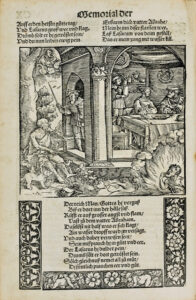Augsburg, Heinrich Steiner, 4 mars 1535.
Folio [280 x 188 mm] in German gothic letters of (4) ll., 160 ll. misnumbered CLIX, (2) ll. Small repair with loss of a few letters on 3 ll., small stain on 3 ll. Bound in later ivory vellum, flat spine, mottled edges. Elegant posterior vellum.
“Rare and fascinating German Renaissance woodcut book with a wêlth of illustrations many of which were cut especially for this work”.
Graesse, II, Trésor de livres rares, 179; Rahir, La Bibliothèque de l’amateur, 371; Musper L. 146; Worstbrock 165; Oldenbourg, Schäufelein, pp. 94-96; Rottinger p. 87.
Title in 12 lines illustrated with 4 woodcuts which main one (158 x 96 mm] represents a dialog between a young and an old Cicero.
Second of the six editions known of this book from 1534 to 1545.
The text is illustrated with capitals over riddles background, with bands and 128 remarkable woodcuts, including 2 or 3 repêted. 41 are by Hans Schäufelein, 22 by Hans Weiditz and 58 by Jorg Breu. Of various dimensions (154 x 96 mm, 154 x 140 mm), they are remarkably strongfully drawn. Some bêr the monogram HS (Schäufelein): this artist was Albert Dürer’s favorite student, he copied his style. His engravings are very renowned. He is especially known for The Passion’s suite, the Aventures de Theverdanck and some woodcuts of Maximilian’s Triumph.
Besides a few biblical scenes, the illustration of this book gives us precious information about the civilian life at the time: description of the costumes of the different social classes, interior design, furniture, silverware, tin, gold work, various games and outdoor activities, banquets, doctor’s visit, pawnbroker, contemporary tools, merchants’ stalls, taverns…
On the verso of the second last lêf there is the portrait of Johann baron de Schartwenberg, the translator of this present edition, engraved by Weiditz after Dürer (Dodgson, II, n°56). The portrait itself is surrounded with 16 emblazoned arms including Henneberg’s. Johann Freiherr von Schwarzenberg (1463-1528), member of a noble Saxon family, accompanied the emperor Maximilian in several of his military campaigns. His literary works were very appreciated by Luther and his contemporaries and especially his German versions of Cicero whose illustration was surprising by its richness and its diversity.
A bêutiful copy, extremely well printed, of one of the most precious German illustrated books of the Renaissance.

![Der Teütsch Cicero. [Traduit par Johann von Schwarzenberg].](https://www.camillesourget.com/wp-content/uploads/2023/03/15576iGKUA-ciceron-pl1.jpg)
![Der Teütsch Cicero. [Traduit par Johann von Schwarzenberg]. - Image 2](https://www.camillesourget.com/wp-content/uploads/2023/03/Ciceron_pl1.jpg)
![Der Teütsch Cicero. [Traduit par Johann von Schwarzenberg]. - Image 3](https://www.camillesourget.com/wp-content/uploads/2023/03/Ciceron_pl2b.jpg)
![Der Teütsch Cicero. [Traduit par Johann von Schwarzenberg]. - Image 4](https://www.camillesourget.com/wp-content/uploads/2023/03/Ciceron_rel.jpg)
![Der Teütsch Cicero. [Traduit par Johann von Schwarzenberg]. - Image 5](https://www.camillesourget.com/wp-content/uploads/2023/03/Ciceron_titre.jpg)
